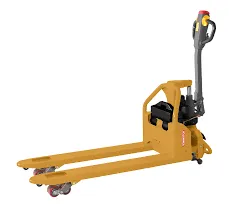


Understanding Manual Pallet Lifters A Comprehensive Guide
Manual pallet lifters, often referred to as manual pallet jacks, are essential tools in warehouses, distribution centers, and retail environments. These devices are designed to facilitate the lifting and transporting of palletized goods. With their simple yet effective design, manual pallet lifters provide an ergonomic solution for material handling, helping reduce strain on workers and increasing efficiency in operations.
Features and Functionality
A manual pallet lifter typically consists of a pair of forks, a hydraulic pump, and a handle for steering and control. The forks slide beneath a pallet, and with a few pumps of the handle, the hydraulic system elevates the pallet off the ground. This lift capability allows workers to move heavy loads with relative ease, minimizing the risk of injury from lifting.
The lifting height of manual pallet lifters usually ranges between 3 to 7 inches from the ground, depending on the model. Fork lengths may vary, with standard lengths being around 48 inches, though shorter or longer options are available to accommodate different pallet sizes. Most manual pallet jacks can support loads ranging from 2,200 to 5,500 pounds, providing ample capability for various applications.
Advantages of Manual Pallet Lifters
One of the primary benefits of manual pallet lifters is their affordability compared to electric-powered alternatives. They require no electricity or batteries, making them a cost-effective option for companies looking to streamline their material handling processes without significant investment. Their operation is straightforward, allowing for easy training of staff and quick integration into existing workflows.

Additionally, manual pallet lifters are relatively low maintenance, which can help reduce operational costs over time. Regular inspections and minor repairs ensure longevity, making them a durable choice in environments with heavy use.
Safety Considerations
While manual pallet lifters are generally safe to use, workers should adhere to some safety guidelines to prevent accidents. Proper training on how to operate the device is crucial. Workers should always ensure that the load is balanced and within the weight limits of the pallet jack. It's also essential to navigate around obstacles carefully and to communicate clearly with other team members in busy environments.
Users should be aware of their surroundings and maintain a safe distance from hazards. Wearing appropriate personal protective equipment (PPE), such as steel-toed shoes, can further enhance safety.
Conclusion
Manual pallet lifters are invaluable additions to any facility focused on efficient material handling. They not only improve productivity by allowing workers to move heavy loads with ease but also promote a safer workplace by reducing the risk of manual lifting injuries. Understanding their features, advantages, and safe operating procedures can help businesses leverage these tools effectively, ultimately contributing to smoother operations and enhanced worker satisfaction. As industries continue to evolve, the manual pallet lifter will undoubtedly remain a major player in the hierarchy of material handling equipment.



